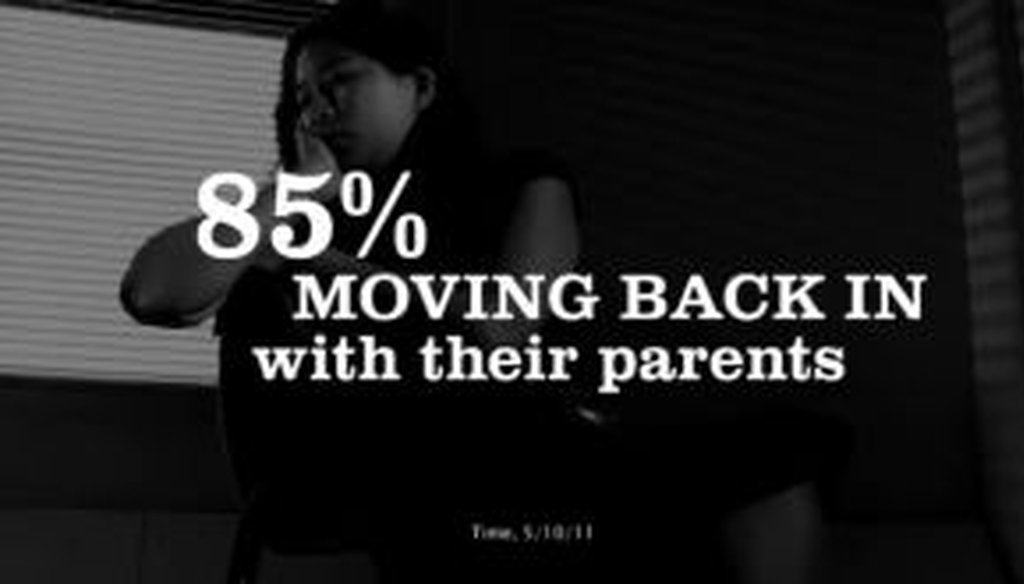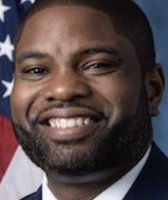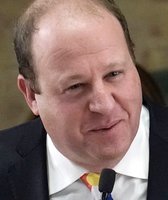Get PolitiFact in your inbox.

In a recent ad, the Republican-aligned group American Crossroads blamed President Barack Obama for 85 percent of recent college grads having to move home. But long before the ad ran, the media missed multiple opportunities to check the figure's validity.
Journalists love to write about a trend -- particularly when they can back it up with eye-popping numbers.
That's been the case with the much-hyped phenomenon of college graduates moving back with their parents. To illustrate the trend, many media outlets cited a stunning figure -- that 85 percent of recent college grads were returning to live with Mom and Dad.
"Boomerang kids: 85% of college grads move home," blared a headline on CNNMoney.com. "85% of college grads return to nest," echoed the New York Post. "Survey: 85% of New College Grads Move Back in with Mom and Dad," said Time magazine’s website.
Recently, the 85 percent figure emerged in the presidential campaign, in an ad from the Republican group American Crossroads that blames President Barack Obama for the boomerang.
We rated the claim False, but as we dug into the number, we found the media had repeated it with little scrutiny. Journalists were content to copy a number from other news reports without verifying it -- or even asking when the survey was conducted.
If the reporters had looked deeper, they would have found some oddities about the firm that claimed to have conducted the survey, a Philadelphia-area company called Twentysomething. The company's website had an impressive list of staffers, but when we checked on them, we found several who either didn't work for the company or appeared to be fictional.
We tracked down the president of the company, David A. Morrison, in the Bahamas, where he said he "owns many homes." He said the company went out of business a few years ago and that the survey is now out of date. He answered some of our questions but then ended the call, asking us not to contact him again.
The echo chamber
The trend of college graduates moving back in with their parents has been a durable one for journalists. Eventually, it secured a catchy hook -- "the boomerang generation."
It played to the recession fears of grads and parents, and conjured the age-old tensions of generations living under the same roof.
The first mention of the 85 percent figure came in a CNNMoney.com report in November 2010:
"Meet the boomerangers. This recession has hit young adults particularly hard," according to Rich Morin, senior editor at the Pew Research Center in D.C. So hard that a whopping 85 percent of college seniors planned to move back home with their parents after graduation last May, according to a poll by Twentysomething Inc., a marketing and research firm based in Philadelphia. That rate has steadily risen from 67% in 2006. ‘It's peaking at levels we have not seen before,’ said David Morrison, managing director and founder of Twentysomething."
It also popped up in the New York Post and Time. As recently as two weeks ago, it was cited by U.S. News & World Report.
It's also been mentioned on websites and blogs -- twice in the Huffington Post, and once in the personal finance blog PT Money. It was picked up by bloggers on the left (Democratic Underground) and the right (Free Republic), each offering their own political spin. (We reached out to some of the reporters who used the statistic but did not receive any responses.)
In some cases, as in the CNNMoney.com story, the 85 percent figure was paired with an earlier finding of 67 percent in 2006, suggesting that the trend has increased in recent years -- a theme that fit nicely with the American Crossroads ad, which blamed the trend on having "four years of a celebrity president." The ad specifically cited the Time item as its source.
But as the 85 percent figure spread in the media over the past few years, there was no journalistic scrutiny.
While Twentysomething was consistently cited as the source, the news accounts provided no details about the poll's methodology, sample size -- or even the dates the survey was conducted. The CNNMoney article was the only one that even indicated the reporter had spoken with Morrison.
Reporters are taught to get details about a survey so that they can judge its validity. But if they had tried, they would have quickly found that no such information was available.
There were no details about the poll on Twentysomething's website. When we tracked down Morrison, the company president, he said the poll had been done for a client "many years ago" but would not release any details about the methodology, citing a binding non-disclosure agreement with the client, whom he would not name.
Given that the survey was outdated, Morrison said it was not accurate to use the statistic the way the Crossroads ad did.
He said, "These numbers tend to get recycled."
'Core team member'
Morrison earned an MBA from the University of Pennsylvania’s Wharton School. The company's website says he consulted with more than 50 Fortune 500 companies "including Coca-Cola, Toyota, Procter & Gamble, Apple, McDonald's, Nokia, Kraft, Time Warner, General Motors and Citibank."
He billed Twentysomething as a niche consulting firm that helped companies target young adults. Its website dubs the firm "the corporate world's bridge to the fountain of youth." It listed offices in London, Mexico City, Munich, Paris, Sao Paulo, Seoul, Sydney, and Tokyo.
As the head of Twentysomething, Morrison provided a treasured commodity for journalists writing about the trend of college grads moving home: a voice of authority.
In 2008, the New York Sun published a story headlined, "Degrees in Hand, Manhattanites Making Move to Old Bedrooms." It said, "According to consumer research company twentysomething.org, about 65% of young adults plan to move home for some time following college graduation, and that number rises to 70% in places such as New York, where rents are so high, the president of the company, David Morrison, said."
Over the next year or two, as the recession worsened, stories about "boomerang kids" proliferated, and Morrison became journalists’ go-to guy for commentary. He was quoted in pieces by the Boston Globe, the Fort Wayne Journal Gazette, the Washington Post, the Chicago Tribune, the Dallas Morning News, the Associated Press, CNN, NPR and PBS’s Nightly Business Report.
As we delved into Twentysomething’s website, we began noticing oddities. The phone number for its headquarters in Philadelphia had been disconnected, and the website appeared not to have been updated since 2009 -- well before the 85 percent stories began appearing in the media.
The staff page was particularly odd. The second person listed as a "core team member" on the firm’s staff list was "Daniel Jay, vice president for client management," further described as "the visionary dude that brought herbal tea in the mainstream United States!"
Initially we couldn’t locate a Daniel Jay who fit the description, but then we found a website for Daniel Jay Morrison & Associates Inc., a New Jersey-based marketing consulting firm. He emailed us back, "David is my son and I worked on specific, contained projects (primarily via electronic mail) with him." But the website did not use Daniel Jay Morrison’s full name or identify him as Morrison’s father.
Michael Lieberman, listed as director of statistics, said in a telephone interview that he had never been affiliated with Twentysomething, and he added that the biographical details included in his Twentysomething bio -- which he confirmed were accurate -- were public knowledge.
We also tried to find Manolo Barberena, listed as director of international operations for Twentysomething. Barberena worked for a Miami-based firm called Kitelab, but when we called Kitelab, one of his colleagues, Carlos de Leon, said that Barberena had never worked for Twentysomething. De Leon said Barberena died a year ago.
Another strange twist: We found the photos of two employees -- Susan Deane, the senior analyst for qualitative research, and Lisa Bray-Wilson, the client services coordinator -- to be of questionable origin. When we checked the images through the Google search engine, we found they appeared to be stock photos that had been used on other websites.
The image of Deane is found on Flickr as "confident happy young African American business woman smiling" and appeared on the blogs Madame Noire, Motivators And Creators Women's Group and Tickled by Life. The photograph of Bray-Wilson has appeared on numerous sites for black women and even payday loan sites.
And the last press release issued by Twentysomething listed as the media contact a woman who told PolitiFact she didn’t write the release.
When Daniel Jay Morrison, David Morrison’s father, was asked to confirm the other employees or the range of foreign offices of Twentysomething, he said, "I cannot provide information regarding the other employees or locations."
When David Morrison himself returned our call, we began to ask him about some of the discrepancies on his website. He declined to answer the questions and asked that we not call him again.
'Eighty-five percent? Come on!'
A Nexis search reveals Morrison hasn't been quoted in the media for about a year and a half, but the 85 percent figure lives on, most recently in the Crossroads ad. (A Crossroads spokesman declined to comment.)
Based on our research, we can't confirm the validity of the survey because we haven't see any details about it and Morrison declined to provide them. We rated the claim False because Morrison said the number was based on a survey done "many years ago" and that economists have said Obama has had limited impact on the economy so can't reasonably be blamed for boomerang kids. Also, a study released by the Pew Research Center before the Crossroads ad appeared found rates no higher than about 40 percent, and possibly lower, depending on what age range is included in the data.
Erik Wemple, who writes about the media for the Washington Post, expressed surprise that no one in the newsrooms citing the 85 percent figure used their "gut common sense" to question such a high number.
"Eighty-five percent? Come on! Maybe the poll said they came home once for dinner before their first job interview," Wemple said. Without getting the documentation, reporters can't be sure the number is valid.
But once a claim enters the mainstream media, it’s hard to put the genie back in the bottle. "The dynamic of trust is built with each link," Wemple said. "It barely occurs to anybody that all those links may be built on a straw foundation."
Our Sources
American Crossroads, "Cool" (ad), April 26, 2012
Pew Research Center, "The Boomerang Generation: Feeling OK about Living with Mom and Dad," March 15, 2012
Twentysomething Consulting and Research, website, accessed April 30, 2012
Time, "Survey: 85% of New College Grads Move Back in with Mom and Dad," May 10, 2011
New York Post, "85% of college grads return to nest," May 7, 2011
CNNMoney.com, "Boomerang kids: 85% of college grads move home," Nov. 15, 2010
U.S. News and World Report, "The Economic Reality Behind HBO’s 'Girls,'" April 16, 2012
Huffington Post, "2011 College Grads Moving Home In Record Numbers, Saddled With Historic Levels Of Student Loan Debt," May 13, 2011
Huffington Post, "Moving Home: When College Grads Face Uncertain Futures," May 24, 2011
PT Money "The Boomerang Generation: College Graduates Moving Back Home," accessed May 2, 2012
New York Sun, "Degrees in Hand, Manhattanites Making Move to Old Bedrooms," July 31, 2008
Boston Globe, "The boomerang kids: Struggling to make ends meet, adults are moving back in with their folks," Jan. 13, 2009
Fort Wayne Journal Gazette, "Moving back home not so bad," March 26, 2009 (accessed via Nexis)
Washington Post, "Back Home to Roost: Some Make Do in the Recession by Moving In With Dad and Mom," April 26, 2009
Chicago Tribune, "Boomerang effect: Young adults move back home to save money," Jan. 4, 2010
Dallas Morning News, "More young adults forced to move back in with Mom, Dad," Dec. 13, 2009
Associated Press, "Number of `boomerang kids' shot up as economy plummeted," Nov, 25, 2009
CNN, "Grads finding it easier to move back home," Oct. 17, 2010 (accessed via Nexis)
PBS, Nightly Business Report, July 1, 2010 (accessed via Nexis)
PolitiFact, "American Crossroads ad says 85 percent of recent college grads are moving in with Mom and Dad," May 1, 2012
Interview with Phyllis Stevenson, media relations coordinator for the Wharton School at the University of Pennsylvania, May 2, 2012
Email interview with Daniel Jay Morrison, Daniel Jay Morrison & Associates Inc., May 1, 2012
Interview with Michael Lieberman, founder and president of Multivariate Solutions, April 30, 2012
Email interview with Michael Englisch, former employee of Twentysomething, April 30, 2012
Interview with Carlos de León, director of the Hispanic business unit at Kitelab USA, May 2, 2012
Interview with Courtney Goethals Dobrow, former publicist for Kaplan, April 30, 2012
Interview with Erik Wemple, media columnist for the Washington Post, May 2, 2012
Interview with David Morrison, managing director and founding partner of Twentysomething Consulting and Research, May 1, 2012


































